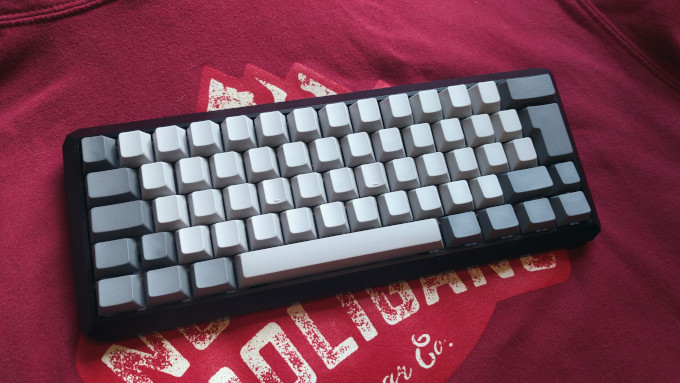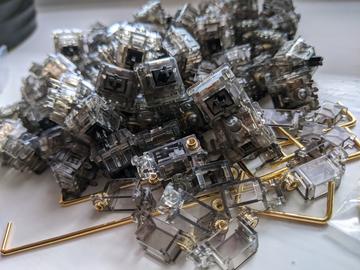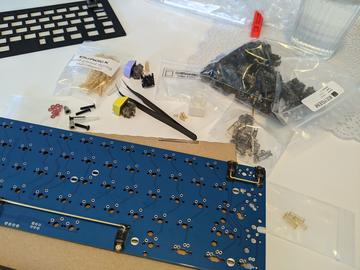My keyboard — May 2021
This is the story about the time when I spent a lot of money and almost upgraded my keyboard. Heh..
Specifications
| Keyboard: | Custom |
| Size: | 60% |
| Case: | KBDfans Diamond |
| Circuit board: | Sentraq S60-X |
| Switches: | Gateron Red |
| Stabilizers: | GMK Screw-in stabilizers by GMK Electronic Design (Space bar key) |
| DUROCK Screw-in stabilizers V2 (Backspace and Enter key) | |
| Keycaps: | NPKC Blank PBT (Cherry-profile) |
| Birthday: | 2018-01-19 |
The (almost) update
After about two years since the last changes to my keyboard, I decided it was time to make changes to it again. I bought the highly regarded L7 linear switches, screw-in stabilizers and some 55 gram springs, all from DUROCK. I think I spent about 100 EUR on it in total.
The switches are available in various weights, with the lightest weighting in at 62 grams, which is still way to heavy for me. My current switches have 45 gram springs, and I find them just perfect for me. The reason I went with 55 gram springs was simply because it was the only thing available at the moment, and I decided to buy them and take my chances.
Modding the switches
It took me a couple of hours to open the switch houses, replace the spring and then applying the almost invincible switch film on all 63 switches. The film is not required, but it’s a good thing to have it on some switches from certain brands after you have opened them. Some brands are prone to become unstable and wobbly, and it can also impact the sound of the switches as well.
Building the new keyboard
My plan was to use a PCB that I bought a couple of years ago; the Plain60-B. I didn’t need it at the time, but it was cheap (about 30 EUR), available and I knew that I—at some point—wanted to build a second custom keyboard, I was just patiently waiting for the right switches; something that was end-game material, but at the same time affordable and something that didn’t need lubrication to be decently smooth. Something like the DUROCK switches that I just bought.
Well. Somehow, I had totally missed that what makes the DUROCK switches good, is the fact that they come slightly factory lubed. And yes. I know that pretty much every single person in the custom keyboard community absolutely love lubricated switches. I’m just not one of them.
While I like the sound and smoothness of lubricated switches, I find them sluggish. I prefer the more ‘mechanical’ feel to my switches, not some rubbery feeling. And yes, I’m aware of the fact that I’m probably never going to have the smoothest switches, but I’m okay with that. Smooth enough is fine for me.
The PCB
Plain60-B is a rather simple and affordable PCB, that’s designed to support as little layouts as possible without limiting usability for most users. It doesn’t even feature LEDs or underglow.
It supports both the VIA and the QMK firmware. And as a creature of habit, I went with QMK as always. If you want to read about my layout, check out my post about my custom keyboard layout. The post is about two years old, so I might do an update on that soon.
After modding all the switches, I soldered them on to the PCB. I then applied the stabilizer foam on the PCB, which helps to dampen the sound when bottoming the keys out as you type. I then assembled the stabilizers. I had also applied stabilizer shrinks on the stabilizer stems and slightly lubed to make them sound better.
The final result
Then it was time for the big moment, and, well.. It was just one large pile of disappointment. The switches and stabilizers sounded good, but the first travel distance of the switches felt sluggish and it didn’t really help that the springs was slightly too heavy for me. The stabilizers felt quite mushy, but that turned out to be due to the stabilizer shrinks.
I wasn’t happy at all, to the point that after less than a week of usage I actually reverting pretty much all my changes to the keyboard.
I went back to my old PCB, but I did replace the old GMK screw-in stabilizers with the new ones from DUROCK. This time without the stabilizer shrinks, and it was a success, except for the fact that the spacebar felt weird. It felt a big sluggish, and after multiple tweaks and no success, I replaced the stabilizer with the old one from GMK.
The GMK screw-in stabilizers doesn’t sound as good as the ones from DUROCK (not that they sound terrible either, their old models are after all considered to be one of the best stabilizers out there), but in the end; function is more important than sound for me.
Future plans
I don’t have a proper desoldering station, so I’m going to outsource that job to my good friend towhatend. The PCB will be used for a future project (with my favourite switch; Gateron Red) and the DUROCK switches will be sold on the secondhand market to someone who actually likes good sounding, but sluggi.. lubricated switches.




Comments
There's no comments for this post. Use this e-mail form if you would like to leave a /public/ comment on this post. Or simply send me a private e-mail message if you have any feedback, or just want to say hello.